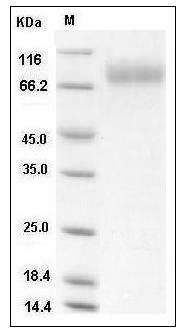-
Product Name
H3N2 Neuraminidase (His Tag) recombinant protein
- Documents
-
Description
Neuraminidases are enzymes that cleave sialic acid groups from glycoproteins. Influenza neuraminidase is a type of neuraminidase found on the surface of influenza viruses that enables the virus to be released from the host cell. Influenza neuraminidase is composed of four identical subunits arranged in a square. It is normally attached to the virus surface through a long protein stalk. The active sites are in a deep depression on the upper surface. They bind to polysaccharide chains and clip off the sugars at the end. The surface of neuraminidase is decorated with several polysaccharide chains that are similar to the polysaccharide chains that decorate our own cell surface proteins. Neuraminidase (NA) and hemagglutinin (HA) are major membrane glycoproteins found on the surface of influenza virus. Hemagglutinin binds to the sialic acid-containing receptors on the surface of host cells during initial infection and at the end of an infectious cycle. Neuraminidase, on the other hand, cleaves the HA-sialic acid bondage from the newly formed virions and the host cell receptors during budding. Neuraminidase thus is described as a receptor-destroying enzyme which facilitates virus release and efficient spread of the progeny virus from cell to cell. Influenza antibody and influenza antibodies are very important research tools for influenza diagnosis, influenza vaccine development, and anti-influenza virus therapy development. Monoclonal or polyclonal antibody can be raised with protein based antigen or peptide based antigen. Antibody raised with protein based antigen could have better specificity and/or binding affinity than antibody raised with peptide based antigen, but cost associated with the recombinant protein antigen is usually higher. Anti influenza virus hemagglutinin (HA) monoclonal antibody or polyclonal antibody can be used for ELISA assay, western blotting detection, Immunohistochemistry (IHC), flow cytometry, neutralization assay, hemagglutinin inhibition assay, and early diagnosis of influenza viral infection. NovoPro has developed state-of-the-art monoclonal antibody development technology platforms: mouse monoclonal antibody and rabbit monoclonal antibody. Our rabbit monoclonal antibody platform is one of a kind and offers some unique advantages over mouse monoclonal antibodies, such as high affinity, low cross-reactivity with rabbit polyclonal antibodies.
-
Protein name
Neuraminidase
-
Uniprot ID
C0LU95
-
Gene Name
NA
-
Source/Expression Host
Human Cells
-
Expression Plasmid/cDNA
A DNA sequence encoding the Influenza A H3N2 virus (A/Babol/36/2005) Neuraminidase (ACN50232.1) (His 36-Pro 459) was fused with a polyhistidine tag at the N-terminus.
-
Protein Species
H3N2
-
Molecular weight
The recombinant influenza H3N2 virus neuraminidase (A/Babol/36/2005 (H3N2)) comprises 443 amino acids and has a predicted molecular mass of 49.6 kDa. The apparent molecular mass of the recombinant protein is approximately 80 kDa in SDS-PAGE under reducing conditions due to glycosylation.
-
Purity
> 90 % as determined by SDS-PAGE
-
Validations

Influenza A H3N2 (A/Babol/36/2005) Neuraminidase / NA (His Tag) SDS-PAGE
Related Products / Services
Please note: All products are "FOR RESEARCH USE ONLY AND ARE NOT INTENDED FOR DIAGNOSTIC OR THERAPEUTIC USE"
